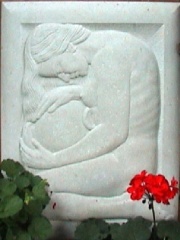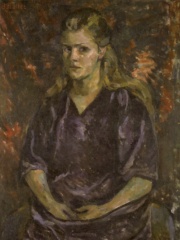
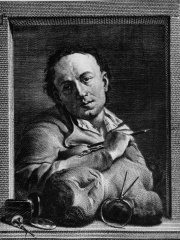
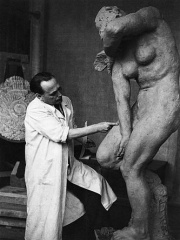
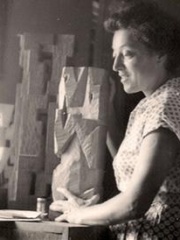
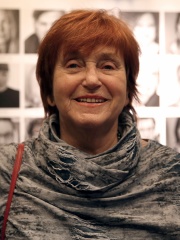
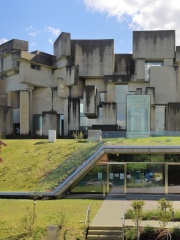
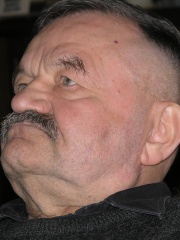
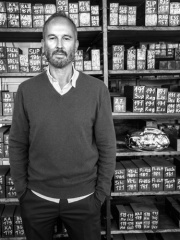
The Most Famous
SCULPTORS from Austria
This page contains a list of the greatest Austrian Sculptors. The pantheon dataset contains 258 Sculptors, 11 of which were born in Austria. This makes Austria the birth place of the 7th most number of Sculptors behind Greece, and United Kingdom.
Top 10
The following people are considered by Pantheon to be the top 10 most legendary Austrian Sculptors of all time. This list of famous Austrian Sculptors is sorted by HPI (Historical Popularity Index), a metric that aggregates information on a biography's online popularity. Visit the rankings page to view the entire list of Austrian Sculptors.

1. Anna Mahler (1904 - 1988)
With an HPI of 63.49, Anna Mahler is the most famous Austrian Sculptor. Her biography has been translated into 25 different languages on wikipedia.
Anna Justine Mahler (15 June 1904 – 3 June 1988) was an Austrian sculptor.

2. Georg Rafael Donner (1693 - 1741)
With an HPI of 61.88, Georg Rafael Donner is the 2nd most famous Austrian Sculptor. His biography has been translated into 18 different languages.
Georg Rafael Donner (24 May 1693 – 15 February 1741) was one of the most prolific Austrian sculptors of the 18th century. His style was baroque with some pseudo-ancient additions. He educated many German sculptors of his era, including his son Matthäus Donner. Donner was born in Essling, Vienna. His work was inspired by nature and by antique sculpture which was deposited in the Vienna's academy. One of Donner's most famous works is Donnersteig in Mirabel Castle, Salzburg (1725–1727), for which he sculpted life-size marble figures. From 1728 he worked in Pozsony at the court of count-bishop Emeric (or Imre) Esterházy, where he sculpted a gravestone for Bishop Esterházy and a horse monument of St. Martin. For almost 10 years he had his studio in the garden of the Summer Archbishop's Palace, at that time just outside Pozsony. In Vienna he created two fountains: Fountain of Austria's rivers (1737–1739) and the source with the sculptures of Perzei and Andromeda in front of the City Hall (1739). One of his last works is the Pieta at the cathedral in Gurk (1741). He died in Vienna. Georg Rafael Donner was recently selected as the main motif of the Austrian gold euro commemorative coin: The sculpture coin was issued on 13 November 2002. The obverse has a portrait of Donner, with the Palace of the Lower Belvedere in the background. This palace is currently the museum of baroque art in Vienna, and contains much of Donner's work.

3. Antun Augustinčić (1900 - 1979)
With an HPI of 61.09, Antun Augustinčić is the 3rd most famous Austrian Sculptor. His biography has been translated into 19 different languages.
Antun Augustinčić (4 May 1900 – 10 May 1979) was a Croatian sculptor active in Yugoslavia and the United States. Along with Ivan Meštrović and Frano Kršinić, he is considered one of the three most important Croatian sculptors of the 20th century. His most notable sculptures include the Peace monument which stands in front of the United Nations building in New York City, the Miner statue in front of the International Labour Organization headquarters in Geneva, and the sculpture of Yugoslav president Josip Broz Tito, present in several copies throughout former Yugoslavia.

4. Magda Frank (1914 - 2010)
With an HPI of 60.86, Magda Frank is the 4th most famous Austrian Sculptor. Her biography has been translated into 23 different languages.
Magda Frank Fischer (20 July 1914 – 23 June 2010) was a Hungarian-Argentine sculptor.
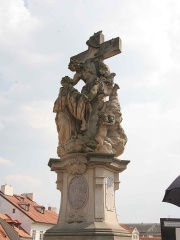
5. Matthias Braun (1684 - 1738)
With an HPI of 57.78, Matthias Braun is the 5th most famous Austrian Sculptor. His biography has been translated into 18 different languages.
Matthias Bernard Braun (Czech: Matyáš Bernard Braun, 24 February 1684 in Sautens, County of Tyrol – 15 February 1738 in Prague) was a sculptor and carver active in the Kingdom of Bohemia, one of the most prominent late baroque style sculptors in the area. Matthias Bernard Braun was born as the fifth child of Jacob Braun and Magdalene born Neureuter. He apprenticed in the Holy Roman Empire where he was born in Salzburg, in the Republic of Venice, and in the Papal States in Bologna and Rome. In his work, it is the Italian influence, that is the most prominent. He was inspired by Michelangelo Buonarroti, Gian Lorenzo Bernini and by the Venetian sculptural school of the 17th century and thus became a great propagator of the Italian-provenience sculpture in the Central-European context. Some time before 1710, Braun came to visit Prague (also in the Holy Roman Empire), already as a full-fledged artist creating from sandstone, and soon he became domestic in Bohemia. He found his wife and friends there, and became a citizen to the New Town of Prague. Already his first work - the statuary of the Vision of St. Luthgard (Czech: Vidění sv. Luitgardy) from 1710, situated on Charles Bridge in Prague - brought to him much attention and many new orders. Braun then was able to found the biggest workshop in Prague, employing six journeymen and having an income of 900 golden a year around 1725. Soon, he himself could not manage the number of new commissions for Prague palaces, gardens, churches and many other places in Bohemia, a situation worsened by the progressing tuberculosis. That is why he only created the designs and models, had his cooperators realize them and completed the work into the final appearance. He had five children, none of which continued his work, though. He died in Prague in 1738. Matthias Braun is probably the most famous for his collection of the allegories of Virtues and Vices situated at the Kuks Hospital in Bohemia, a commission of count František Antonín Špork. Other notable sculptures include: the Bethlehem - monumental statues chiselled directly in sandstone rocks near Kuks, forty pitoresque statues of dwarfs at the Kuks race-course, several statuaries at Charles Bridge in Prague, statues in St. Kliment's Church in Prague, the stone pillar of the Holy Trinity in Teplice, the sculptures in the interior of Czernin palace (Prague), and many others. There is an asteroid named Mathiasbraun (number 6768), discovered in 1983.

6. Valie Export (b. 1940)
With an HPI of 57.74, Valie Export is the 6th most famous Austrian Sculptor. Her biography has been translated into 21 different languages.
Valie Export (often stylized as 'VALIE EXPORT'; born 17 May 1940) is an avant-garde Austrian artist. She is best known for provocative public performances and expanded cinema work. Her artistic work also includes video installations, computer animations, photography, sculpture and publications covering contemporary art.

7. Fritz Wotruba (1907 - 1975)
With an HPI of 56.45, Fritz Wotruba is the 7th most famous Austrian Sculptor. His biography has been translated into 16 different languages.
Fritz Wotruba (23 April 1907, Vienna, Austria – 28 August 1975, Vienna) was an Austrian sculptor of Czecho-Hungarian descent. He was considered one of the most notable sculptors of the 20th century in Austria. In his work, he increasingly dissolves figurative components in favor of geometrical abstraction with the shape of the cube as the basic form.

8. Alfred Hrdlicka (1928 - 2009)
With an HPI of 56.12, Alfred Hrdlicka is the 8th most famous Austrian Sculptor. His biography has been translated into 19 different languages.
Alfred Hrdlicka (German pronunciation: [ˌalfʁeːt ˈhʁdlɪtʃka]; 27 February 1928 – 5 December 2009) was an Austrian sculptor, painter, and professor. His surname is sometimes written Hrdlička. He was born in Vienna into the family of a Czech communist and trade unionist. After learning to be a dental technician from 1943 to 1945, Hrdlicka studied painting until 1952 at the Akademie der bildenden Künste under Albert Paris Gütersloh and Josef Dobrowsky. Afterwards he studied sculpture until 1957 under Fritz Wotruba. In 1960 he had his first exhibition in Vienna; in 1964 he attained international attention as a representative of Austria at the Venice Biennale, Italy. In 2008, his new religious work about the Apostles, Religion, Flesh and Power, attracted criticism about its homoerotic theme. The exhibition was housed in the museum of the St. Stephen's Cathedral of Vienna. He taught many sculptors, such as Hans Sailer, Angela Laich and others.

9. Erwin Wurm (b. 1954)
With an HPI of 55.69, Erwin Wurm is the 9th most famous Austrian Sculptor. His biography has been translated into 22 different languages.
Erwin Wurm (born 1954) is an Austrian artist. He lives and works in Vienna and Limberg in Austria; Hydra, Greece; and in New York City.
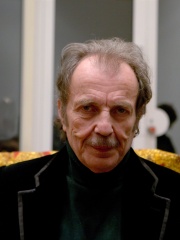
10. Franz West (1947 - 2012)
With an HPI of 54.73, Franz West is the 10th most famous Austrian Sculptor. His biography has been translated into 17 different languages.
Franz West (16 February 1947 – 25 July 2012) was an Austrian artist. He is best known for his unconventional objects and sculptures, installations and furniture work which often require an involvement of the audience.
People
Pantheon has 11 people classified as Austrian sculptors born between 1684 and 1954. Of these 11, 2 (18.18%) of them are still alive today. The most famous living Austrian sculptors include Valie Export, and Erwin Wurm. The most famous deceased Austrian sculptors include Anna Mahler, Georg Rafael Donner, and Antun Augustinčić.
Living Austrian Sculptors
Go to all RankingsDeceased Austrian Sculptors
Go to all RankingsAnna Mahler
1904 - 1988
HPI: 63.49
Georg Rafael Donner
1693 - 1741
HPI: 61.88
Antun Augustinčić
1900 - 1979
HPI: 61.09
Magda Frank
1914 - 2010
HPI: 60.86
Matthias Braun
1684 - 1738
HPI: 57.78
Fritz Wotruba
1907 - 1975
HPI: 56.45
Alfred Hrdlicka
1928 - 2009
HPI: 56.12
Franz West
1947 - 2012
HPI: 54.73
Hellmuth Marx
1915 - 2002
HPI: 54.62
Overlapping Lives
Which Sculptors were alive at the same time? This visualization shows the lifespans of the 7 most globally memorable Sculptors since 1700.

